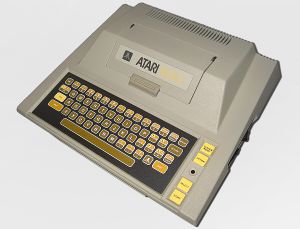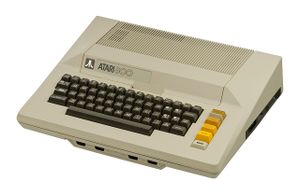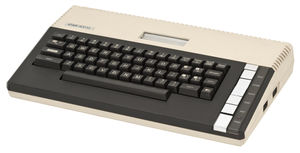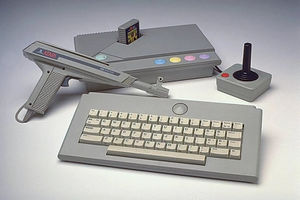Atari 8-bit
The Atari 8-bit computer series, launched in 1979 as the Atari Home Computer System, included the Atari 400 and 800. Powered by the 8-bit MOS Technology 6502 CPU and custom coprocessors, these computers offered advanced graphics and sound for their time.
The Atari 800 was the high-end model, while the 400 was a budget-friendly option with a membrane keyboard and 8 KB of RAM. Both supported plug-and-play peripherals via the Atari SIO (Serial I/O) bus, a precursor to USB technology. The architecture was later used in the 1982 Atari 5200 console, though the systems were not software-compatible.
Newer models followed, beginning with the short-lived 1200XL in 1983, replaced by the 600XL and 800XL. After Atari Corporation took over, the 65XE and 130XE were released in 1985, featuring a lighter design, two joystick ports, and built-in Atari BASIC. The 130XE had 128 KB of RAM.
In 1987, to compete with gaming consoles, Atari repackaged the 65XE as the XEGS, a hybrid console-computer compatible with 8-bit software and peripherals. This marked the final chapter of Atari’s 8-bit computer line.
Since the 1990s, the Atari 8-bit is especially popular in Poland.
Hardware
The 400/800 originally used the standard 6502B CPU. Later 400/800 CPU board was released that used the SALLY 6502C (the C is for custom, not CMOS) chip. The SALLY chip equipped all new Atari 400 & 800, and their successors.
In addition to its 1.79 Mhz 6502 CPU, the Atari computer offloads some of the work to its specialized chips: ANTIC, CTIA & POKEY.
POKEY (POt KEYboard integrated circuit) is a digital Input/Output chip. It handles such disparate tasks as the SIO bus and its peripherals, audio generation, keyboard scan, and random number generation. It also digitizes the resistive paddle inputs and controls maskable interrupt (IRQ) requests from peripherals.
ANTIC and CTIA together produce the graphics, up to a resolution of 320x192 pixels, sprites, scrolling in any direction, different graphic modes that can be mixed on the same screen, etc.
- ANTIC (AlphaNumeric Television Interface Adapter) is dedicated to the preparation of the video signal. It is a true microprocessor; it has an instruction set, a program called "the display list", and data. The display list and the display data are written into RAM by the 6502 CPU. ANTIC retrieves this information from RAM using Direct Memory Access (DMA). It processes the higher-level instructions in the display list and translates these instructions into a real-time stream of simple instructions to CTIA.
- CTIA is a television interface chip. ANTIC directly controls most of CTIA's operations, but the 6502 CPU can be programmed to intercede and control some or all of CTIA's functions. CTIA converts the digital commands from ANTIC (or the 6502) into a video signal that goes to the TV set or monitor. CTIA also adds some factors of its own, such as colour values, sprites graphics, and collision detection.
When launched in the US, the Atari 400 & 800 came with a CTIA (Color Television Interface Adapter) chip, which offered 9 graphic and text modes (GR.0-8) in Atari BASIC and a 128-colour palette. In early 1982, CTIA was replaced by GTIA (Graphic Television Interface Adapter), which provided 3 additional graphics modes (GR.9-10-11) in Atari BASIC, with a 256-colour palette. The GTIA chip equipped all new Atari 400 & 800, and their successors.
| Parameter | PAL Atari 8-bit | NTSC Atari 8-bit |
|---|---|---|
| Master Clock Frequency | 17.734475 MHz | 14.31818 MHz |
| Clock Divider | 10 | 8 |
| CPU Clock Speed | 1,773,447 Hz | 1,789,772 Hz |
| Raster Lines per Frame | 312 | 262 |
| CPU Cycles per Line (Standard) | 114 | 114 |
| Total CPU Cycles per Frame | 35,568 | 29,868 |
| Calculated Frame Rate | ~49.86 Hz (1,773,447 / 35,568) |
~59.92 Hz (1,789,772 / 29,868) |
Links
- Gury's Atari 8-bit Forever
- https://atariwiki.org Atari 8bit wiki
- Best of Atari XL/XE game music Volume 1 Volume 2 Volume 3
- Over 50 Atari 400/800 games in under 30 minutes 1000 Atari 8-bit games
- How Atari 8-Bit Computers Work! by The 8-Bit Guy
- De Re Atari PDF version
- Atari 400-800 Service Manual
- POKEY GTIA ANTIC Datasheets
- Oxyron IC reference
- Altirra Hardware Reference Manual Latest (09/2024!) Atari XL hardware documentation
- C64 vs Atari 800XL C64 SID vs Atari Pokey




